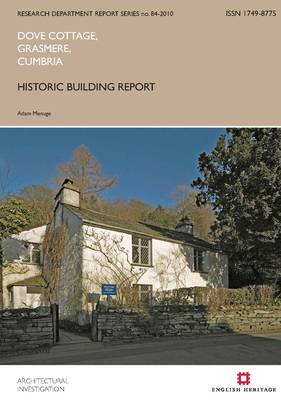
- Afhalen na 1 uur in een winkel met voorraad
- Gratis thuislevering in België vanaf € 30
- Ruim aanbod met 7 miljoen producten
- Afhalen na 1 uur in een winkel met voorraad
- Gratis thuislevering in België vanaf € 30
- Ruim aanbod met 7 miljoen producten
Zoeken
Omschrijving
This report has been prepared in response to a request from the Wordsworth Trust for a detailed understanding of the evolution of Dove Cottage and an assessment of the significance of its various parts (excluding the furniture, exhibits and other movables). It is intended to inform long-term management and interpretation of the house, and forms one element in a broader review of the conservation management and interpretation of the house and garden, last comprehensively overhauled between 1976 and 1979.
Dove Cottage, a Grade I listed building, is internationally famous as the home, between 1799 and 1808, of William and Dorothy Wordsworth, and as the meeting place during their residence of many of the greatest figures of British Romanticism, including Coleridge, Southey, Scott, Wilson and De Quincey. Built as a two-storeyed vernacular house probably in the late 17th century or around 1700, Dove Cottage is constructed of irregular fieldstone rubble with a Cumbrian slate roof. It is built to an irregular plan consisting of a two-bay front range, a single-bay rear range, a small projecting pantry (known to Dorothy Wordsworth as the 'out-jutting') and, at the opposite end of the house, an attached outbuilding, probably intended as a stable. Photographs of the front range, taken when external roughcast was removed in the 1970s, show that it originally incorporated wider, lower windows which must have been mullioned. They were altered to receive taller, narrower casement windows probably in the second quarter of the 18th century, when raised-and-fielded panelling was introduced to the ground-floor rooms of the front range, and several panelled internal doors were introduced. Wordsworth's poem Benjamin the Waggoner is the source for the tradition that the house served as an alehouse (the Dove and Olive Bough) at some point prior to 1799. Corroboration for the tradition comes from an extant record of an alehouse license, granted in respect of premises named only as the 'Dove' at Grasmere in 1791. The Wordsworths made a number of modest but significant alterations during their occupancy. In 1804 they inserted a doorway opening directly from the stair landing into the rear garden. The following year the roof above the 'peat room' was raised to make the small, low and probably ill-lit bedroom in the 'out-jutting' more serviceable; previously, in 1800, they had inserted a new window in an attempt to improve this room. The need to house a growing family, as well as frequent and often long-staying guests, led the Wordsworths to move to a larger house in 1808. Following the Wordsworths' departure the house was refurbished for Thomas De Quincey, who held the lease until 1835. Either he, or one of the acquaintances of the Wordsworths who subsequently occupied the house for short periods, was responsible for inserting the series of Carron fire-grates. From before 1850 until about 1880 the house was occupied by a succession of lodging-house keepers, one of whom also kept a shop on the premises. Probably early in this period the outbuilding was raised to provide domestic accommodation on the first floor. In 1890 the house was acquired by the newly formed Dove Cottage Trust (now the Wordsworth Trust), which opened it to the public the following year. In 1900 a museum opened on the upper floor of the outbuilding and a new boiler house was built adjoining it in 1928. Many small alterations and repairs are documented in the Trust's minute books, and a major overhaul was undertaken in 1976-9 under the direction of Peter Jubb of Newcastle University.Specificaties
Betrokkenen
- Auteur(s):
- Uitgeverij:
Inhoud
- Aantal bladzijden:
- 100
- Taal:
- Engels
- Reeks:
Eigenschappen
- Productcode (EAN):
- 9781848025127
- Verschijningsdatum:
- 1/06/2015
- Uitvoering:
- Paperback
- Formaat:
- Trade paperback (VS)
- Afmetingen:
- 210 mm x 295 mm
- Gewicht:
- 4 g

Alleen bij Standaard Boekhandel
+ 83 punten op je klantenkaart van Standaard Boekhandel
Beoordelingen
We publiceren alleen reviews die voldoen aan de voorwaarden voor reviews. Bekijk onze voorwaarden voor reviews.











